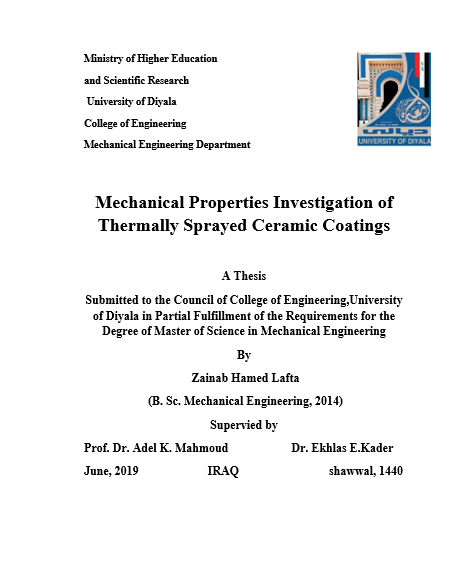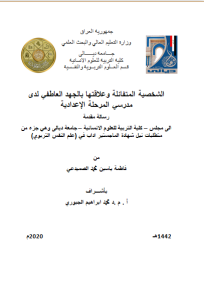ABSTRACT
Flame Spraying (FS) technique has been widely adopted in many industries such as aerospace industries, automobile industries, aircraft industries,…etc., due to its flexibility, and cost effectiveness in producing superior quality of coatings. Also this technique utilized to apply coatings on the components to protect them against wear, heat and corrosion. The present work aims to evaluating of the mechanical properties (hardness, fracture toughness, residual stresses and young modulus) of hybrid ceramic coatings ( ZrO₂ , (ZrO₂+ 15,20 wt%MgO) (ZrO₂ + 40, 80 wt% Al₂O₃), (Al₂O₃+13,40 wt%TiO₂), (Al₂O₃, +25 wt%SiC), SiC, (Al₂O₃, +18 wt%ZrO₂ + 10 wt% SiC)) synthesized by flame spraying coating technique on plain carbon steel (1015) substrate. The hardness are determined by Vickers hardness as an experimentally method, the higher value of the Vickers hardness is 1773 HV of the SiC ceramic coating compared with other ceramic coating. Fracture toughness measurement by Vickers indentation method, the fracture toughness increases from 0.829Mpa√m of (Al₂O₃+20%wt ZrO₂) to a maximum value 1.99MPa√m of (Al₂O₃+40wt% TiO₂) .while the residual stresses are determined by X-Ray diffraction technique, ,the higher value of the compressive residual stresses is -420.974Mpa in the (Al₂O₃, +20% ZrO2) ceramic composite coating. The young modulus is evaluated by Ultrasonic wave technique, the best value is 262Gpa of the (80% ZrO2 +20 wt%MgO) at stressed coating state while unstressed state best value is 270Gpa of the ( ZrO2+ 40 wt%Al2O3 ).Optical microscope , scanning electron microscope (SEM) and Energy dispersive spectroscopy (EDS ) were used to investigate microstructure , surface characteristic and chemical elements. The phase structure of the composite ceramic coating layers is conducted using X-Ray diffraction technique (XRD) . The X-Ray results showed m-ZrO₂ and c- ZrO₂ as the prominent phase in pure ZrO₂ ceramic coating , so in pure SiC ceramic coating is α-SiC, while in composite ceramic coating (Al₂O₃, – 25 wt% SiC) α-Al₂O₃ , Ө- Al₂O & α-SiC, and cubic for magnesia, tetragonal and monoclinic zirconia for (ZrO₂ + 15,20 wt%MgO) also (Al₂O₃,+13,40 wt% TiO2) α -Al₂O₃, & t-TiO2,while α -Al₂O₃, m-ZrO₂ & α-SiC for (Al₂O₃+18 ZrO₂ +10 wt% SiC)and α Al₂O₃,&m-ZrO₂ for (ZrO₂+40wt%Al₂O₃), and α-Al₂O₃,& m-ZrO₂ for (Al₂O₃+20 wt% ZrO₂).The thickness of the sprayed composite coating were from 200 μm to 260 μm for bond coat and 400 μm to 667 μm for top coat coating layer respectively. The best surface characteristics were for ZrO₂ ceramic composite coating layers less surface roughness 5.654μm while low porosity percentage is 6.107% for advanced composite ceramic coating (ZrO₂ + 20 wt%MgO).





